Arriving in Kwun Tong, you hail down a red Hong Kong urban taxi and wave a sheet of paper at the driver. Simultaneously you tell him you want to go to Po Tat Estate. Your written and verbal instructions successfully set you on your way towards the nearby area of Sau Mau Ping in Eastern Kowloon. The short drive takes you on a flyover and into a part of Hong Kong where the landscape is dominated by the standard high-rise cross-shaped public housing blocks. The distinctive design is instantly recognisable from the privately built apartment blocks in the territory. The area has a strong Chiu Chow presence and the immigrants from the province of Guandong have called this part of Hong Kong home for many years. It is something that they have built on two occasions that has drawn you out to this otherwise uninspiring part of town. As your taxi turns onto the Po Lam Road, you see the set of structures that started your journey. The taxi stops and you get out to explore the Tai Shing Miu (大聖廟 Dàshèng Miào) – the Monkey God Temple and its neighbours.
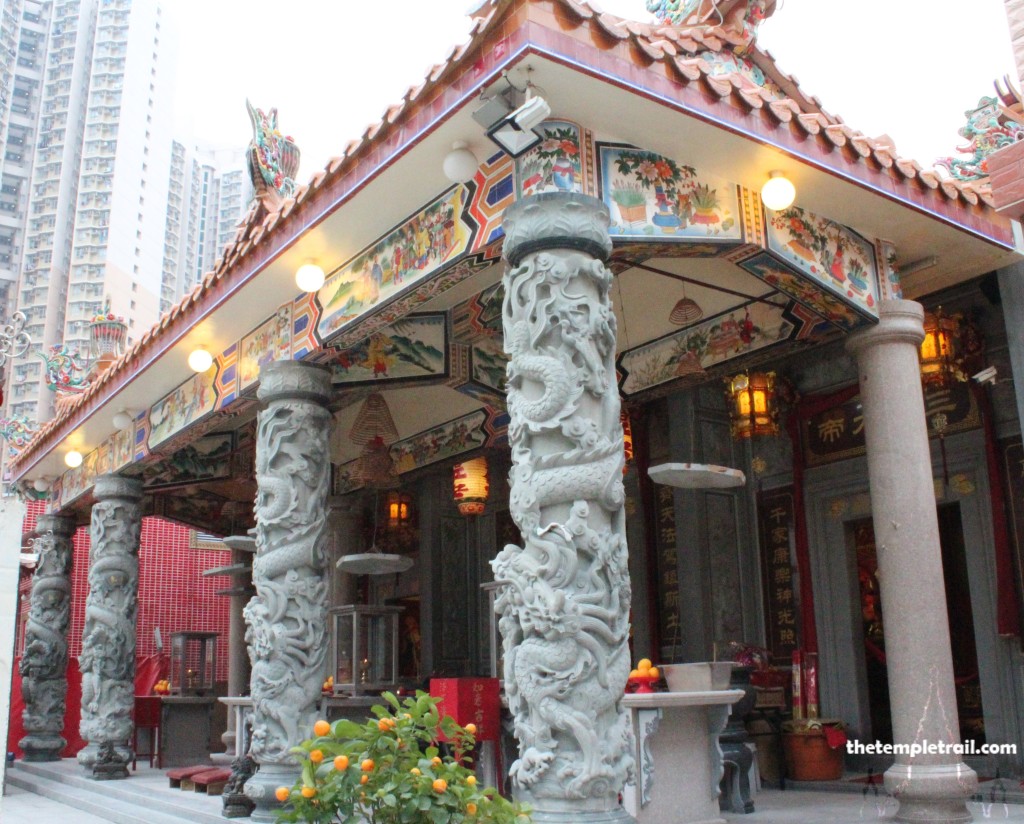
The story of the temple of the Great Sage, Equal of Heaven and how it came to be here is an interesting one. The Sage himself, is also an intriguing character. Born from a famous novel that was itself crafted on historical events, his origins may be even older than fiction dictates. Sun Ng Hung (孫悟空 Sūn Wùkōng) is the Monkey King of the famous Ming Dynasty (1368 – 1644 CE) novel Journey to the West ( 西遊記 Xī Yóu Jì). The story is one of the Four Great Classical Novels of China and is certainly the most well known outside the country. After being born from a stone on a mountain peak, through his wit and bravery the Stone Monkey (石猴 Shí Hóu) became the Handsome Monkey King (美猴王 Měi Hóuwáng) of the Mountain of Flowers and Fruit. He then studied with a famed immortal, Patriarch Subodhi, and became one of the most powerful demons on the earth, taking the name Sūn Wùkōng. He obtained a magical cudgel (如意金箍棒 Rúyì Jīngū Bàn) from Áo Guǎng (敖廣), the Dragon King of the East Sea. Designed by the legendary king Yu the Great (大禹 Dà Yǔ) to measure the depths of the ocean, the staff could change size depending on its master’s wishes. Armed with this powerful weapon, the Monkey King defeated the other three dragon kings to get the Golden Chainmail Shirt (鎖子黃金甲 Suǒzǐ Huáng Jīn Jiǎ), the Phoenix Feather Cap (鳳翅紫金冠 Fèngchìzǐjinguān) and the Cloud-walking Boots (藕絲步雲履 Ǒusībùyúnlǚ). He then went to Hell and wiped his name and those of his fellow monkeys, from the Book of Life and Death, thereby making himself immune to death.
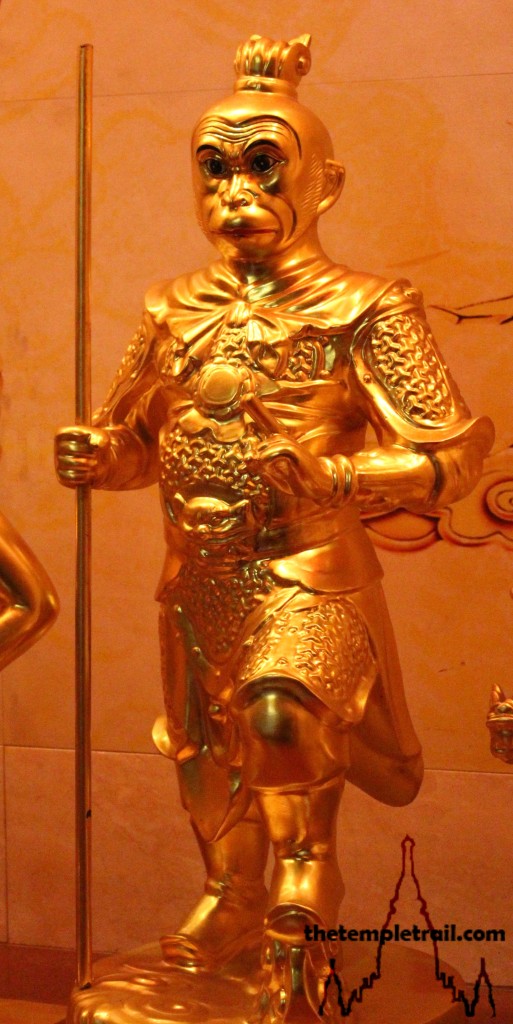
In order to subdue the impetuous monkey, the Jade Emperor (玉帝 Yù Huáng) gave him a lowly position in heaven. Sūn Wùkōng rebelled and called himself Great Sage, Equal of Heaven (齊天大聖 Qítiān Dàshèng), a title that heaven was forced to accept. He rebelled again after being snubbed and ate all of Xī Wáng Mǔ’s Peaches of Immortality and Lǎozǐ’s Pills of Longevity. Through a combined force of Buddhists, Taoists and gods, the Monkey King was captured and put in Lǎozǐ’s Bāguà Crucible to be made into an elixir and retrieve the pills. After 49 days he burst out alive with the new power of golden-gaze fiery-eyes (火眼金睛 jīnjīng huǒyǎn) that enabled him to recognise evil in any form, but also left him sensitive to smoke. The gods finally appealed to Buddha, who imprisoned Sūn Wùkōng under a mountain for five hundred years until his services were required to help the monk Xuánzàng (玄奘) retrieve Buddhist sutras from India. With the help of Pigsy (豬八戒 Zhū Bājiè), a pig monster and Sandy (沙悟浄 Shā Wùjìng), a sand demon, they brought back the teachings and encountered many adventures and trials. Upon their return, Sūn Wùkōng was granted Buddhahood and called Victorious Fighting Buddha (鬥戰勝佛 Dòu Zhànshèng Fó).
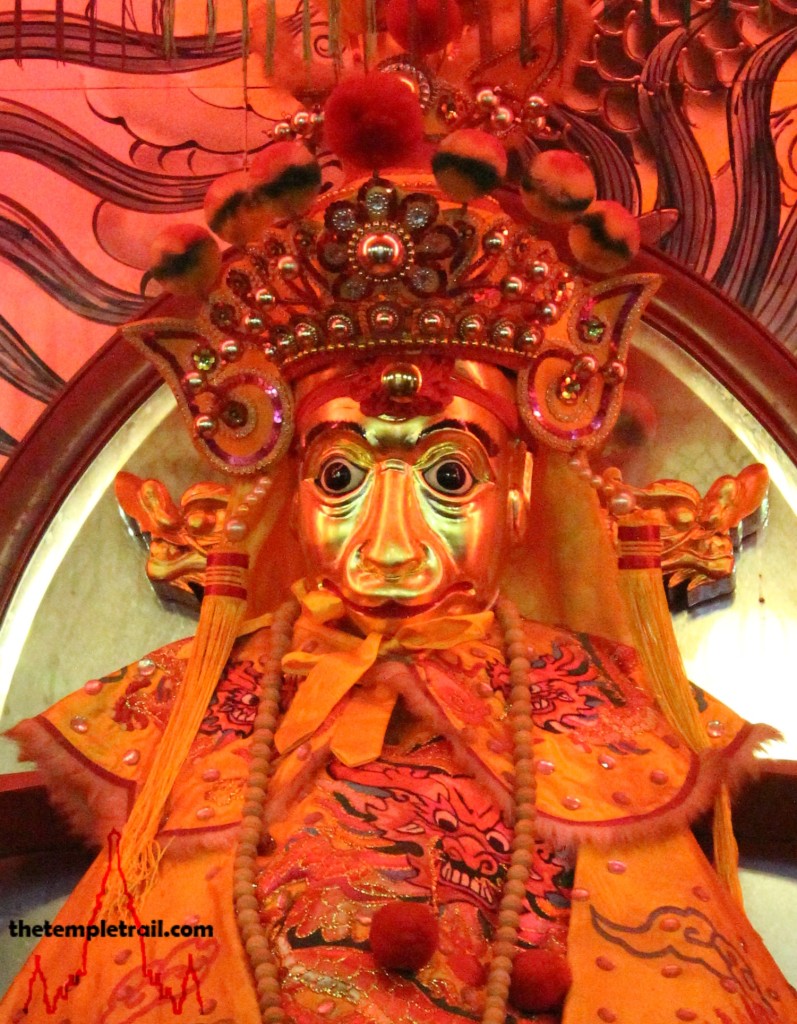
Standing before the new set of temples, you see how the nature of Monkey is irrepressible. The temples here once occupied a site near to the new ones, but they were demolished in 2008 to make room for apartment buildings. The original temple was built by the Chiu Chow community in 1968 under instruction from Great Sage, through his chosen spirit medium. The temple was a smaller yellow roofed structure and sat alongside a Tin Hau Temple (天后廟 Tiān Hòu Miào), a Shing Wong Temple (城隍廟 Chénghuáng Miào) and a Kwun Yum Temple (觀音廟 Guānyīn Miào). These other three temples have also been rebuilt and the set of four new structures is more impressive than the makeshift temples that they replaced. To your left, the Tin Hau Temple is not open to the general public today and seeing the community there busily preparing for some festivities, you decide to give the modern house-like building a miss. Instead you make straight for the main reason for your visit, the Monkey God Temple. Walking up a short ramp, you stand in the courtyard of a new and improved temple. Directly in front of you is an offering table under metal roof. Before it lies the new temple. Completed in 2013, the stone dragon columns display the prestige of the building.
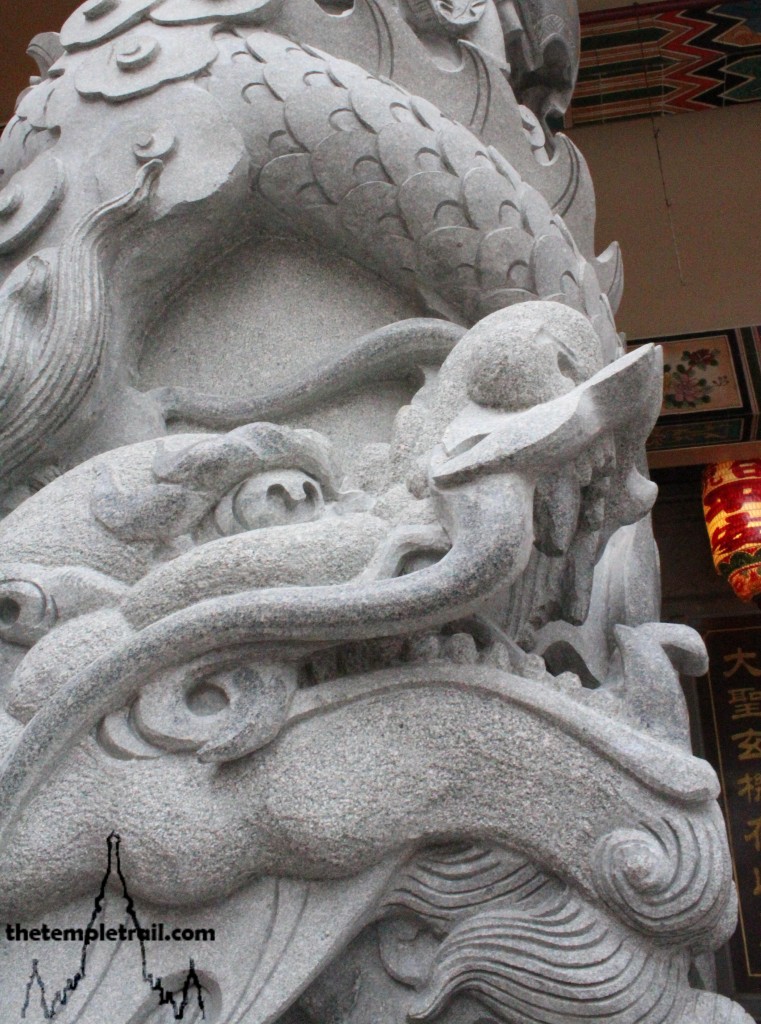
Standing in the awning and looking forward, you see the temple is a tripartite open hall. To your left is a shrine to To Dei Kung (土地公 Tǔ Dì Gōng), the Earth God. Before entering the temple, you greet the temple keeper in the staff building to the right of the temple. This is one of the spirit mediums who channel the Monkey God on special occasions such as his festival on the 16th day of the eighth lunar month. Master Chan, now in his mid-80s, is the primary medium. In the 1950’s Sau Mau Ping became a squatter settlement for refugees from Guangdong, Fujian and people from all over the Min Nan diaspora. The Chiu Chow and Hoklo people made up a large portion of these settlers. In 1964, when he was 34, Master Chan was chosen by the Monkey God to be his medium. It was through him that the god told the local people where he wanted his temple built and four years later the Tai Shing Miu was finished. During festivities, Master Chan still gets possessed and leaps around, though the acts of self-mortification, such as running barefoot across a bed of hot coals, climbing a ladder of 72 blades, washing his face with hot oil, biting glasses and cutting his tongue with a sword no longer happen. When he was ill at 70 years old, the god appeared to him in a dream and extended his life by 19 years for his loyalty.
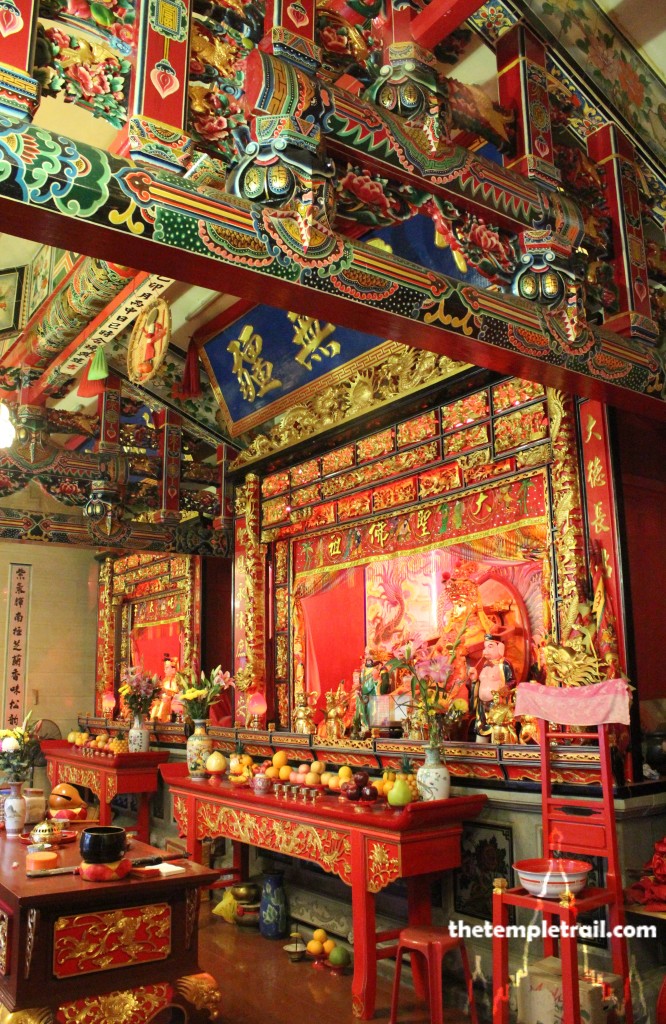
Looking at the intricately carved stone columns and the brightly illustrated cross-beams, you head into the doorway on the right. The façade of the temple past the columns is also intricately carved stone. Passing the offering table in the foyer, you walk through the stone portal, under the gold painted bats above it and enter into the hall. Although it is roped off just after the entrance, you are close enough. To either side of you, the door gods watch you as you inspect the first altar. On it stand three almost identical statues. These are the Sam Gun Tai Dai (三官大帝 Sān Guān Dà Dì), the Three Great Emperor-Officials. They are the Heavenly Official (天官 Tiān Guān), the Earthly Official (地官 Dì Guān) and the Water Official (水官 Shuǐ Guān). People pray to them to eliminate misfortune, eliminate sins and acquire luck.
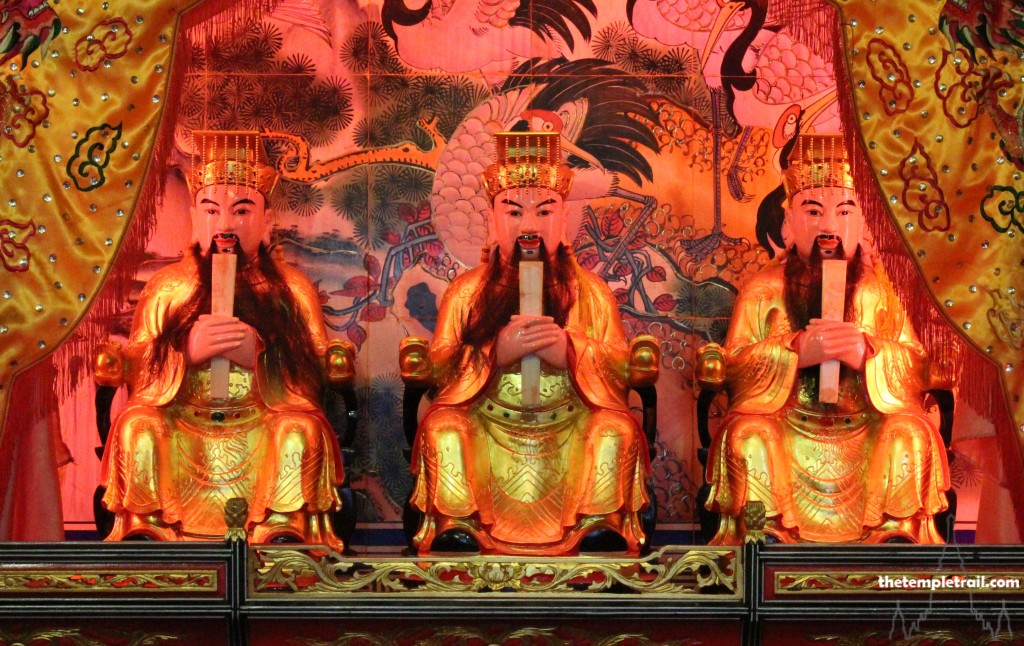
Back out of the chamber you move to the central doorway. Lighting three joss sticks, you plant them into the incense brazier in front of the door. The offering table holds apples and oranges, but no peaches of immortality (仙桃 xiān táo). The fruit is an apt offering for the Tai Shing, as he is a monkey and ruled the Mountain of Flowers and Fruit. Moving into the chamber, you see the golden statue of Sūn Wùkōng before you. His name means Monkey Awakened to Emptiness and was given to him by his first teacher, Patriarch Subodhi. The Chinese people love Sūn Wùkōng, he embodies elements that they adore. He is intelligent and has witty guile. The most popular Chinese folk characters solve their problems and defeat their enemies using cunning and intelligence. He is also a rebel against authority, something that the Chinese, historically a people who disliked the powers that governed them, respect. Although they do not often emulate Monkey’s rebellious deeds, they often aspire to. Journey to the West was a secret searing indictment of corruption. The author, Wú Chéng’ēn (吳承恩), detested being a government official and resigned in order to write. He was supremely disaffected with the political climate of the time and was disillusioned with the corrupt nature of the Ming government.

Sūn Wùkōng, who may have origins in the Indian monkey god Hanuman, looks out from his altar, flanked by Pigsy and Sandy and surrounded by his allies. On the offering table before him lies a sword that is used by the medium for ritual mortification. The ancient blade seems imbued with the potency of the Monkey King’s power. After paying respects to the popular god, you re-enter the chamber through the left-hand door and meet the figures on the altar. Here, the main figure is Na Cha (哪吒 Nézhā), the child god of war. The young god also has his origins in Hinduism as an amalgam of the yakṣa Nalakūbara and the child god Bālakṛṣṇa. Na Cha has some formidable weapons too and he flies through the sky with his Wind Fire Wheels (風火輪 Fēng Huǒ Lún) while using his Fire-tipped Spear (火尖槍 Huǒ Jiān Qiāng) and Universe Ring (乾坤圈 Qián Kūn Quān). In Journey to the West, he is defeated by invincible Sūn Wùkōng. Next to him is Kwun Yum (觀音 Guānyīn), the three eyed Fa Kwong Tai Dai (花光大帝 Huá Guāng Dà Dì) Great emperor of flowering brightness and Lei Kung (雷公 Léi Gōng), the God of Thunder.
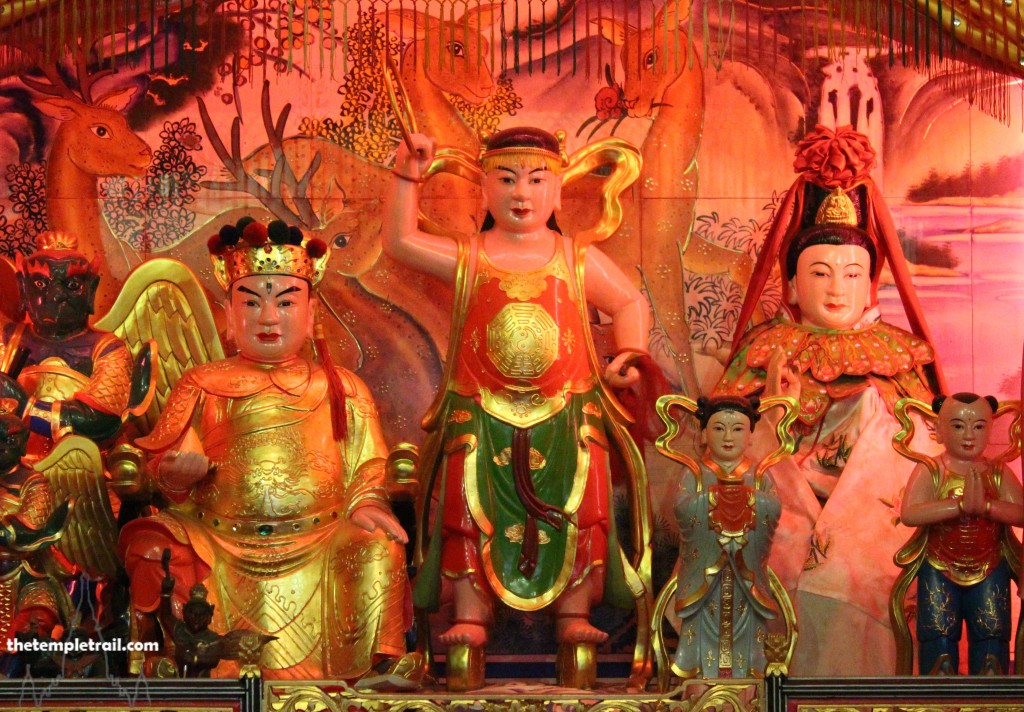
After thanking the aged medium and temple keeper, you leave the Monkey God Temple and walk a few steps to the City God Temple. You climb a short step of stairs and go through a stylised memorial arch (牌坊 páifāng), past a small offering table and into a small single-chamber temple. To your right is the usual shrine to To Dei Kung with a brightly painted statue of the god within. Ahead of you is the main altar containing the large image of Shing Wong (城隍 Chénghuáng), the City God. The ancient god was originally responsible for the protection of the town’s walls and moats. As these defensive features have fallen away, the city god is now responsible for the living and, particularly, the dead of the city. It is to Shing Wong that the residents of Sau Mau Ping pray for their deceased relatives. Either side of the god are his four attendants; two light-faced figures carrying the god’s record book and seal and two dark demons who punish the wicked. You also note the groomsman holding his horse. This temple, though small is filled with bright, modern statues and tearing yourself away from them, you exit and move along to the last temple.
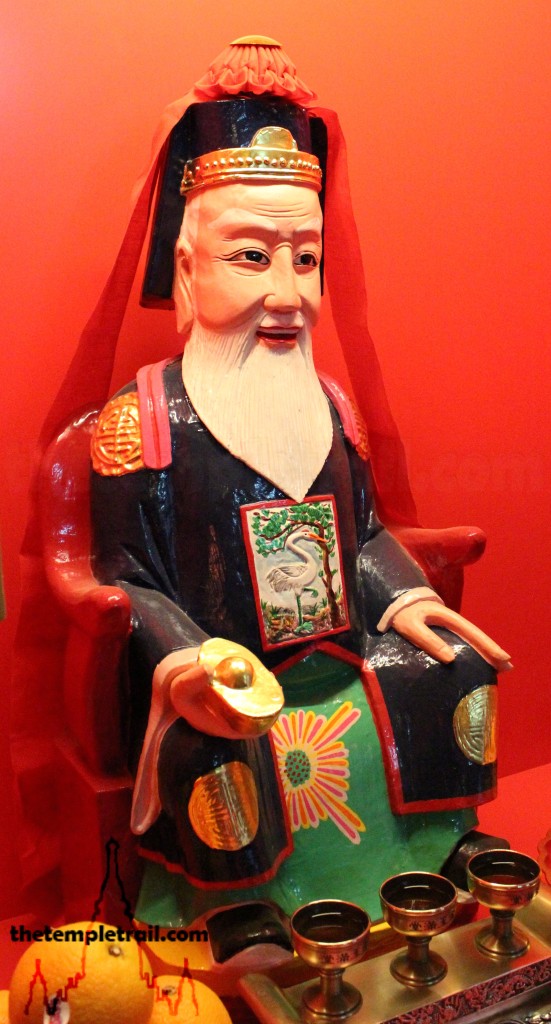
The Kwun Yum Temple is the final one of your visit. Entering the grand gate, you stand before a three-chamber temple. Walking through to the left side of the temple, you note a tiny temple to the left dedicated to San Sun Pak Kung (山神伯公 Shān Shén Bó Gōng). Pak Kung (伯公 Bó Gōng), sometimes called She Kung (社公 Shè Gōng), is district protector deity and a manifestation of the Earth God. San Sun, meaning “Mountain Deity”, indicates that he is the family ancestral home protector. As the Chiu Chow are far from their homeland, they have brought their family god with them and they pray to him to keep their ancestors happy. This god was probably installed by the families who founded the Kwun Yum Temple.
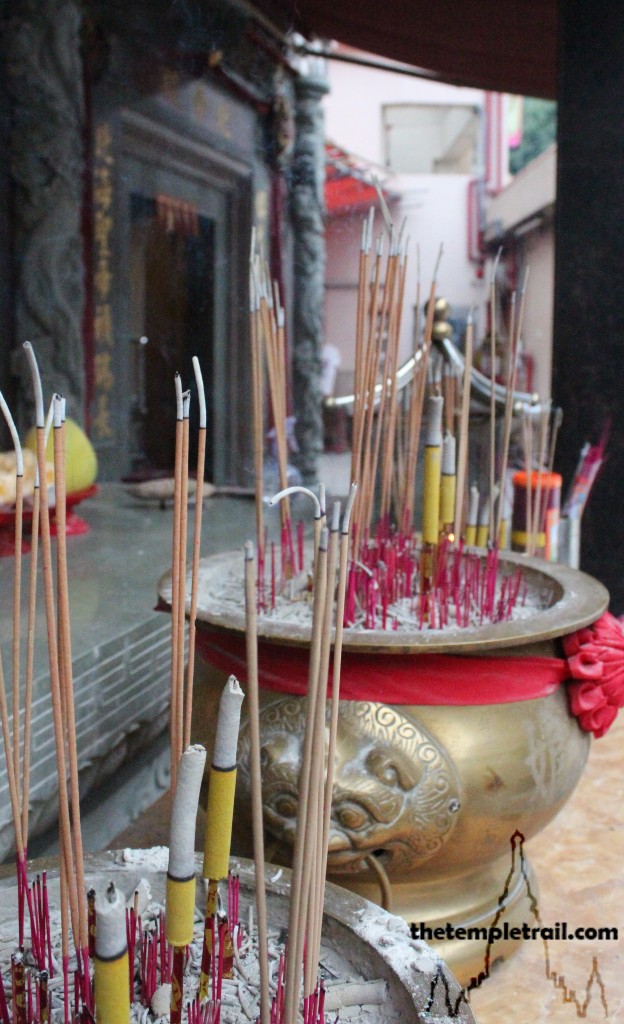
Turning back to the main temple and entering the left-hand chamber, you are in the room for Kwun Yum as a Taoist deity. On your right, next to the door is a beautiful dark wooden statue of Kwun Yum, the Goddess of Mercy and her to child attendants; Yuk Nui (玉女 Yùnǚ), the Jade Girl and Kam Tung (金童 Jīntóng), the Golden Boy. Kwun Yum is not in her Buddhist form, as she does not have the Buddha Amitabha in her crown. The main altar has a statue of the goddess along with other deities including Tin Hau (天后 Tiān Hòu) and Dau Mo (斗母 Dǒu Mǔ), the Pole Star and Goddess of Measure.

You go out of the room and enter the central one. This hall is dedicated to Kwun Yum as a Buddhist Bodhisattva. Stepping through the door, you are surrounded by the Sei Tai Tin Wong (四大天王 Sì Dà Tiānwáng – Four Heavenly Kings). These fierce directional guardians protect Buddhist temples. After passing them, you then process past the Sap Bat Lo Hon (十八羅漢 Shíbā Luóhàn) – Eighteen Arhats. The eighteen Buddhist saints are beautifully rendered and the expressions on their faces paint their personalities perfectly. The original statues in this temple were carved from wood in the 1950s when the first temple was built. Sadly, these now sit in storage and have been replaced by the new statues on the main altar. As you approach it, you see Kwun Yum occupying the centre surrounded by golden figures of other Buddhist luminaries.
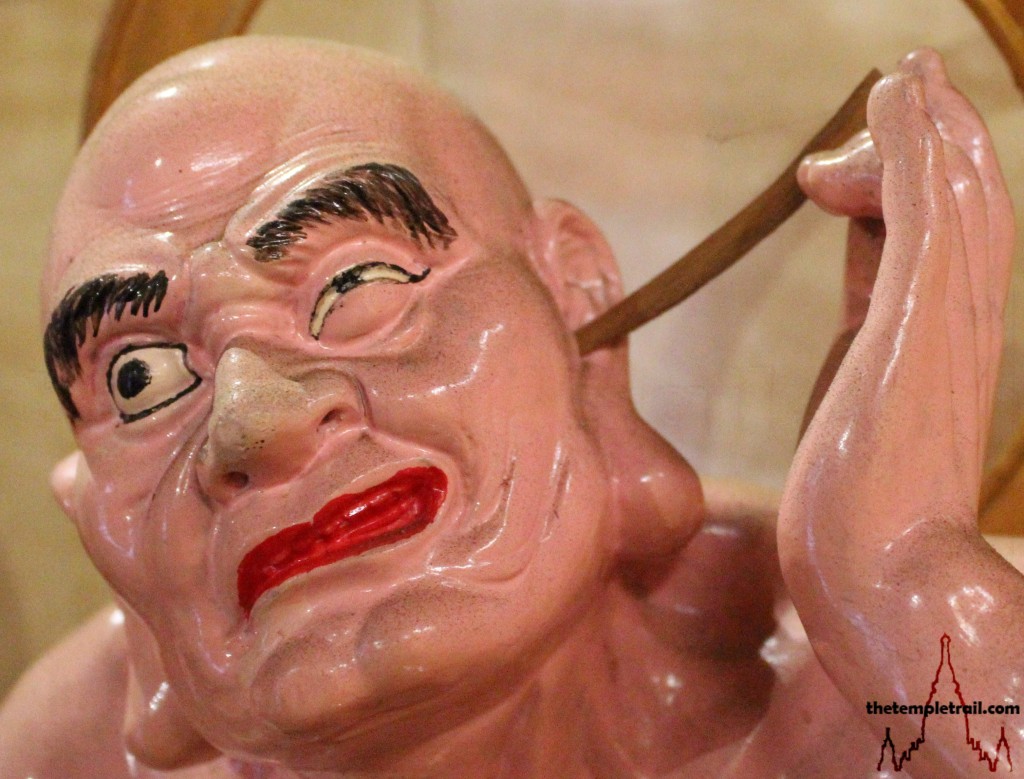
The last hall welcomes you with its darker interior. Two dragon columns stand next to the offering table and the golden glow of the altar statues emanates from behind. In the centre is Pak Tai (北帝 Běidì), the Barefoot Emperor of the North. This ancient and mysterious martial god is very popular and is associated with the winter, as are his two animal companions, the turtle and the snake. On both sides of Pak Tai, the Supreme Emperor of the Jade Void, are numerous deities. Both of the main wealth gods, Choi Sun (財神 Cái Shén) and Ziu Kung Ming (赵公明 Zhào Gōng Míng), who rides on his black tiger, are present, as are Kwan Kung (關公 Guān Gōng), Fa Kwong Tai Dai, Lei Kung and Sūn Wùkōng.
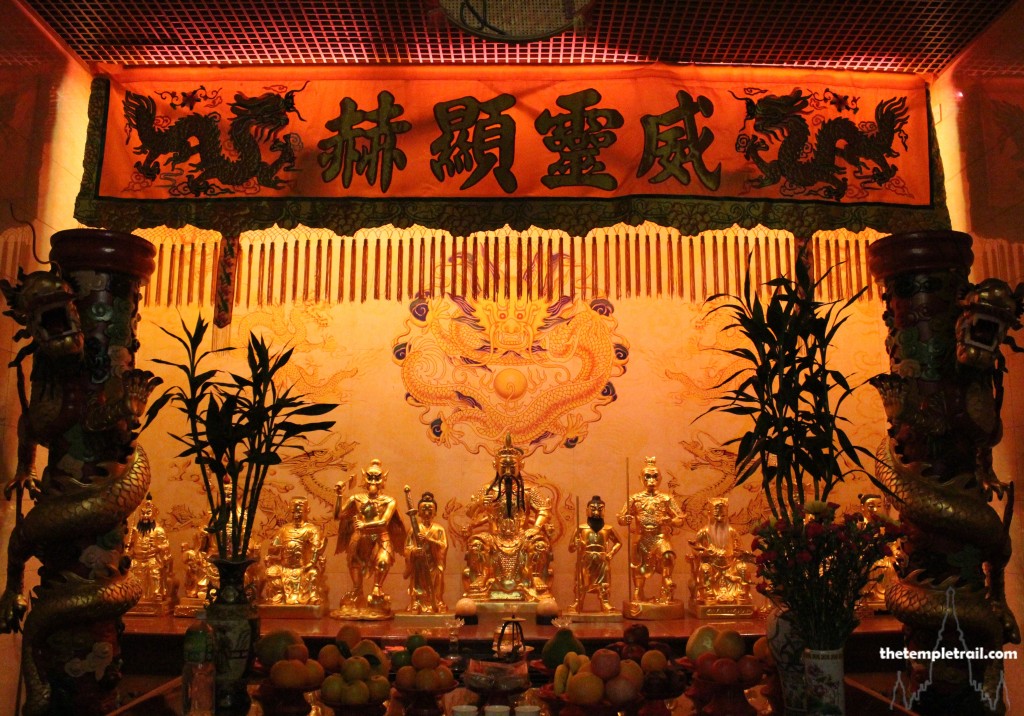
Leaving this array of gods, you leave the temple and walk back down the road. The buildings that have risen from the rubble are more impressive than the originals, some of which were illegal corrugated iron structures hanging of the edge of the hill. The beautiful temples are testament to the tenacity and devotion of the local people who left their homeland and endured hardships in a squatter town, only to see their holy sites torn down years later. They have rebuilt what they lost with the help of the strong community they have maintained throughout all of the tough times. Stronger than ever, much like their temples, the local people will endure and as you cross the road and flag down a taxi, you hope that these new temples will serve them for generations to come.
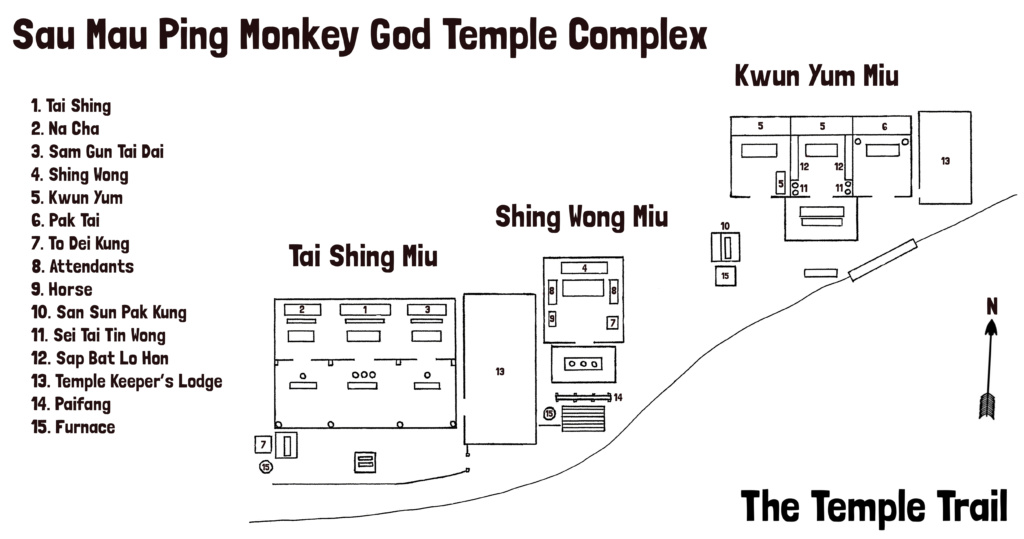

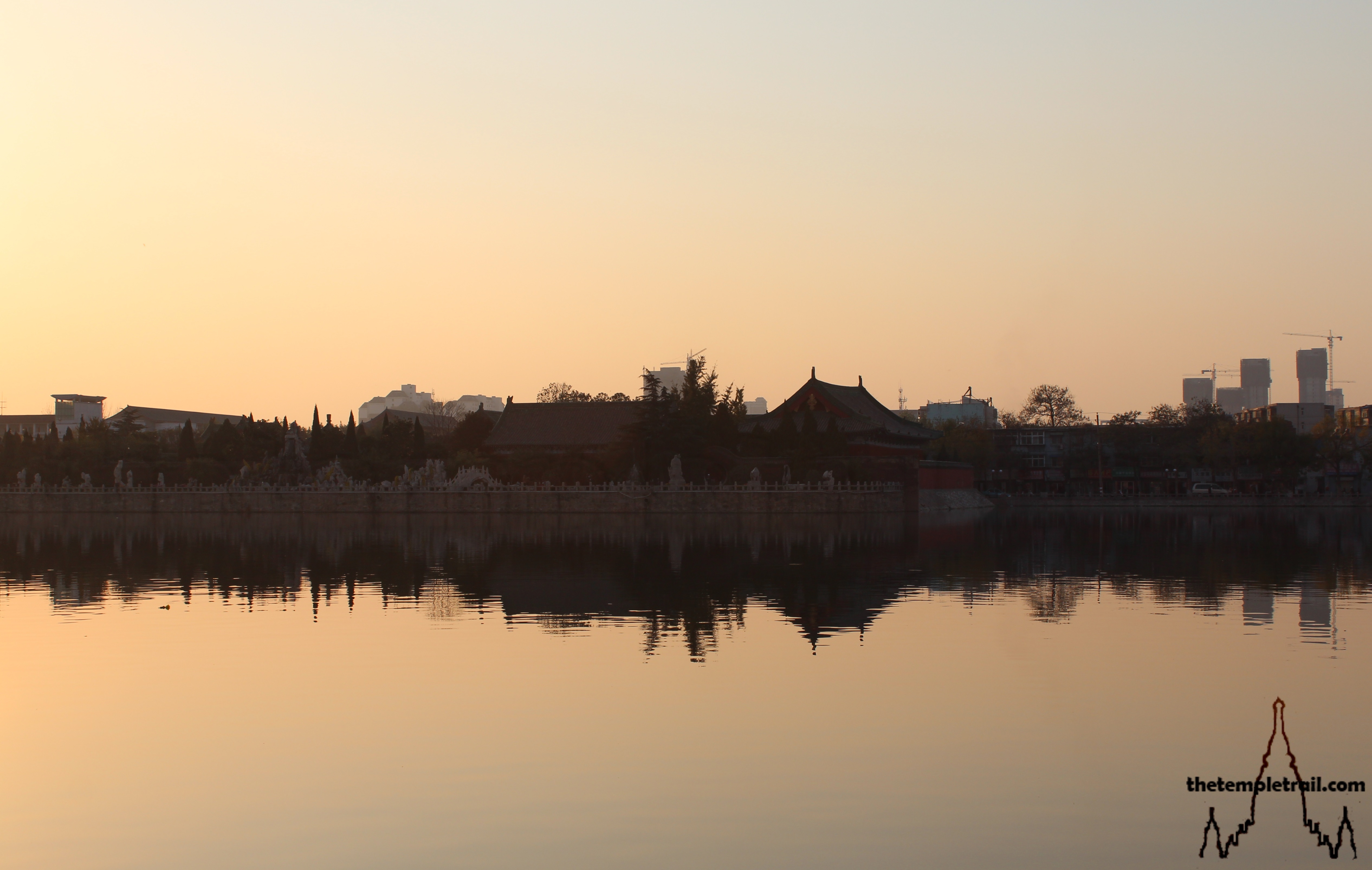 Bao Gong Temple, Kaifeng
Bao Gong Temple, Kaifeng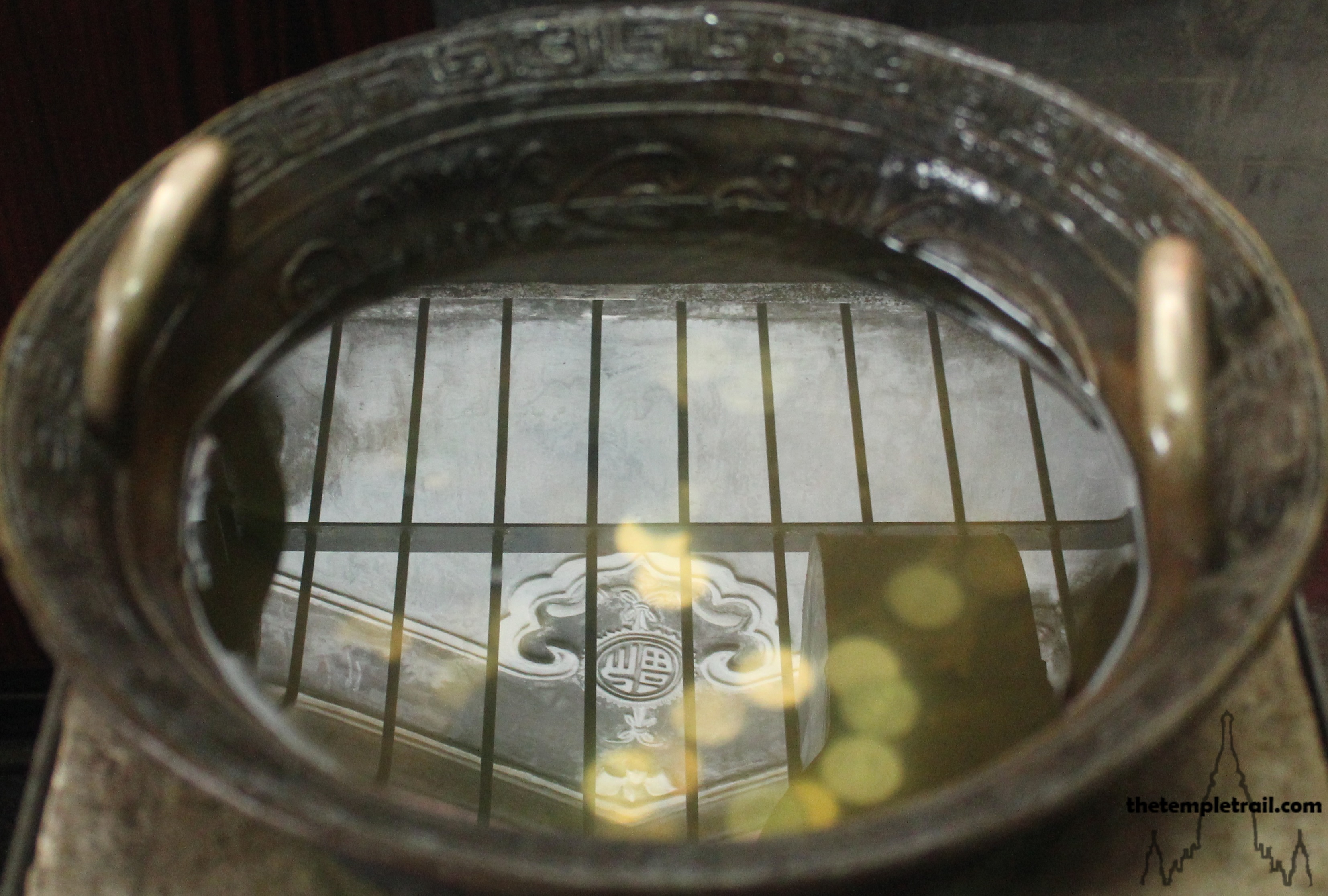
Thank you for this well written article.I have a strong affinity with this particular group of sacred temples and always visit them during my stay in Hong Kong.I have had many magical experiences with these temples and first visited them when they were located in the the nearby hills.The energy they had then was also very sacred and powerful although the temple designs were more simply built.Mind you that did not take away from the palpable spiritual energy that emanated from all of the shrines.By the way I am caucasian and my wife is from Hong Kong.We live in Vancouver, British Columbia,Canada.Her grandmother who lives in Kwun Tong first told us about this particular group of temples.I first payed my respects there in 2007 and remember seeing all the sign posts from the Hong Kong government saying the area would be redeveloped.I have my own spiritual roots in the Taoist path and other traditions so have been familiar with all the holy beings in these shrines. I honor all of the holy beings from these temples in my home shrine.One thing I always remember is that all the temple keepers were so friendly and welcoming to me back then and every time I visit.My last visit being in October of 2017.I am always happy to share more info about my experiences with this group of temples ,especially from the context of being a foreigner.Thank you.
Hi Mark
I am so please that you enjoyed my article. I am also very pleased that you have such a strong affinity with these temples – they are, as you say, potent spiritual places.
Thank you for sharing your experiences.
Tom